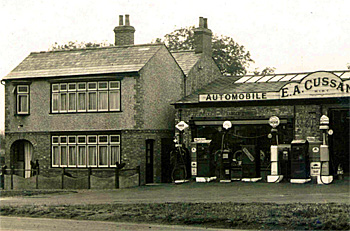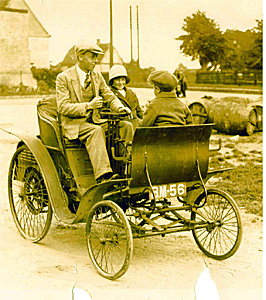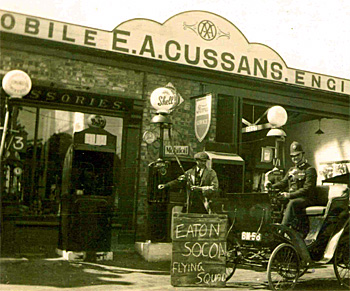Ernest Cussans - Motor Mechanic

Ernie's garage and original cottage
Thelma Marks of Colmworth has written a piece about an important Wyboston character of the 1920s and 30s, Ernest Cussans.
The World War One armistice brought men home to their sweethearts and Ernest Cussans arrived back to the arms of Dorrie, the eldest daughter of William Hull, a farmer and dealer in stock, who lived at Church Farm, Roxton. They married immediately and Ernest told his father-in-law of his hopes and dreams, for by this time the happy couple were both in their mid twenties. Before the war, Ernest had been in north London, both working and studying to get his engineering exams. He was very ambitious and knew where he wanted to go. . . to be independent and own his own garage. During the war, Ernest had become first a dispatch rider and later a lorry driver and mechanic, areas where his skills were best used.

Ernie (on the right) with a mate and a Daimler lorry
Searching the district, Ernest had found a small modern cottage, alongside a roadside garage situated back from the Great North road behind a little green in the village of Wyboston. William Hull readily agreed to a loan for its purchase and development. Ernest immediately knocked down the garage to build a larger modern garage fitted with all modern aids and sufficiently large to house a number of cars for servicing and repairs.
Although he employed help, Ernest, (now known affectionately as Ernie,) was open 24 hours a day and was personally available around the clock. But it must be remembered that the traffic on the Great North Road was sparse in those days.

The garage and house after improvements
The Lorries drivers were known as the ‘Knights of the Road’ and they readily would stop to help one another and any other motorist in trouble. Life was slower and cannot be compared with the frenetic hiatus of today. The surfaces of the roads were very poor and it has been recorded that at that time, it took four days to get from this part of the world to Devon.
Those were the heyday day of the AA and RAC, whose men dressed smartly to match their motorcycles and sidecars: bright yellow for the AA and navy and red for the RAC patrolled the roads to help motorist, who had broken down. Otherwise a motorist must hail another to stop and ask them to call at the nearest garage to make the owner aware of their problems. In these circumstances, Ernie Cussans built himself an excellent reputation and a prosperous business that allowed him to pay back the loan from his father in law within ten years.

Ernie with his children in his Mercedes-Benz
His pride and joy was his Mercedes Benz, which he kept on the forecourt to attract people to stop and admire it. He also partook in the Brighton run with it, only selling it when he decided to retire just before World War 2 .
Over the years he had kept a small boat for recreation and holidays at Brightlingsea, so when he decide to sell the garage, he bought a house with some land on the outskirts of that small Essex town and then built a row of houses as part of his pension.
Shortly afterwards, the Second World War was declared and after a while, Ernie not being quite 50 years old, he was conscripted in to a Munitions Factory. Then one of his new houses was bombed and damaged his new road . . .
Ernie’s bad luck did not finish there, for he had always been a heavy smoker. It was then found that he had cancer of one lung, which was removed. He soldiered on, but it was not long before the cancer had moved to his other lung, Refusing further help, Ernie died in his own home with Dorrie and my mother looking after them.
I’m truly glad that Ernie and Dorrie did not live to see the demolition of their home and garage at Wyboston, when the new carriage way for the A1 swept all before it and burying it all under tarmac. Audrey and Richard, their two children, both left the district and married but had no family. So as their niece, I am recording this saga of history, which I remember well.

Ernie and the local policeman about 1930